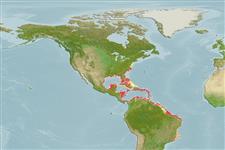Common names from other countries
>
Scombriformes (Mackerels) >
Scombridae (Mackerels, tunas, bonitos) > Scombrinae
Etymology: Scomberomorus: Latin, scomber = mackerel + Greek, moros = silly, stupid (Ref. 45335).
More on author: Bloch.
Environment: milieu / climate zone / depth range / distribution range
Ecologia
marinhas associadas(os) a recifes; oceanódromo (Ref. 51243); intervalo de profundidade 1 - 20 m (Ref. 9710), usually 1 - ? m (Ref. 55288). Tropical; 41°N - 24°S, 99°W - 34°W
Western Atlantic: Massachusetts, USA to Brazil, including the Bahamas and West Indies.
Comprimento de primeira maturação / Tamanho / Peso / Idade
Maturity: Lm 40.5, range 38 - ? cm
Max length : 183 cm TL macho/indeterminado; (Ref. 26340); peso máx. publicado: 7.8 kg (Ref. 4699)
Espinhos dorsais (total) : 16 - 18; Raios dorsais (total) : 15 - 19; Espinhos anais: 0; Raios anais : 15 - 20; Vértebras: 47 - 48. Interpelvic process small and bifid. Lateral line gently curving down toward caudal peduncle. Intestine with 2 folds and 3 limbs. Swim bladder absent. Body covered with small scales. Anterior third of first dorsal fin black. Pelvic fins relatively long. Sides silvery with one long mid-lateral stripe and with several rows of yellow-orange streaks of variable length and small yellow spots above and below the stripe.
Most abundant in clear waters around coral reefs, occasionally forming schools. Feeds on clupeoids (Harengula, Jenkinsia and Opisthonema) and atherinids (Allanetta [= Craterocephalus), squids and shrimps. Good food and game fish (Ref. 5521). Utilized fresh, smoked and frozen; consumed pan-fried, broiled and baked (Ref. 9987). Sometimes called the "Painted Mackerel" (Ref. 13442).
Collette, B.B. and C.E. Nauen, 1983. FAO Species Catalogue. Vol. 2. Scombrids of the world. An annotated and illustrated catalogue of tunas, mackerels, bonitos and related species known to date. Rome: FAO. FAO Fish. Synop. 125(2):137 p. (Ref. 168)
Status na Lista Vermelha da UICN (Ref. 130435)
Can't connect to MySQL database (fbapp). Errorcode: Too many connections
